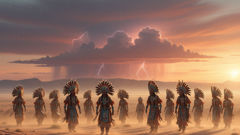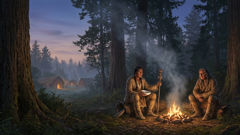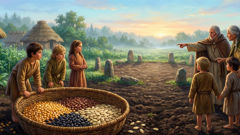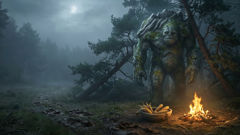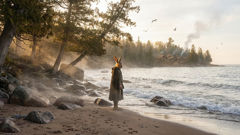Introduction
Before the first rain fell, before the tracks of the oryx stitched the sand, a small, supremely curious creature rose from the heat of the noonday mirage. They called him Cagn, the mantis-shaped god, a creator who laughed with the wind and whispered into the ears of stones. In the beginning there was only a map of possibilities trembling in the air: rivers not yet named, skies without names, animals not yet sure of their steps. Cagn decided to sketch a world by touch and tease, a world where mischief could bloom into wisdom, where the hunted could become teachers, where silence could swell into song. His fingers, nimble as a leaf in a drought breeze, coaxed the earth to become ground for feet, the breath of living things to become a chorus. He picked up a thread of dew and braided the sunrise, then sneaked behind the glow of dusk to listen to the first stories whispered by acacia shadows. The San people would say: he is the creature who would not sit quietly, who learned to trip the future by laughing at it. And so the world began to spin, not in a neat line but in inviting spirals, in questions that have no apologies for being curious, in a ledger where every creature owes something to every other creature. This is the tale of Cagn, a trickster with a heart that beats like a drum and a mind that reshapes the day. The story you are about to read is not a simple fable; it is a map, a memory, and a warning that creation can be playful and dangerous at once, that laughter can be a tool, and that wisdom often wears a grin. When the night air cools and the stars listen, you will sense Cagn’s presence in every ripple of wind across the land, in the careful hunger of a hunter’s eyes, and in the way a child later learns to tell stories by listening first.
Section I — Birth of the World: Cagn’s First Steps
The very first step is always an act of speaking into absence, and Cagn spoke with a mouth that could smile a landscape into existence. He moved with the patient impatience of rain gathering on a leaf, and as his laughter rose, the empty air learned to listen. Rivers woke up as if from a dream, strings of water turning the land into a map that could be walked. Mountains learned to rise in slow silhouettes, not to scare but to invite, a scale model of patience that the wind could study for a century and still discover something new. Cagn did not place order with a ruler; he coaxed order with a joke, a challenge, and a dare, as if the world were a child learning to walk and forgetting every few steps. In these early acts he carved names into the earth: names for the rivers that would carry memory, names for the hills that would shelter a million lives, names for the creatures who would one day tell their own stories of him. The mantis—delicate, patient, and cunning—stood by his shoulder, a small tutor whose green body glowed softly under the desert sun. When he called to the small things—the ants who march in patient lines, the lizards that flicker like coins of green fire—the world learned that even tiny beings could be architects of fate. The day began not with a decree but with a nod, and the night followed, listening for what he would whisper next. And so the land learned to breathe: the wide plains learned to hold breath until the first light spilled, the birds learned to wake with a chorus, and the people learned to read the weather in the way a mother reads the pulse of a child. This section is the hinge where the world is born: not with a single blast of thunder, but with a thousand patient nudges that tell a story of belonging, a narrative in which mischief is a craft, and every step you take has already learned to count. The world, in Cagn’s hands, becomes a ledger of wonder and warning, a place where even a prank carries the seed of a lesson, and where wisdom begins with listening to the smallest sound and ends with a decision to walk kindly toward the future.
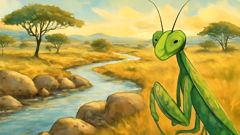
Section II — The Trickster’s Teachings: Lessons for Animals and Humans
If the world is a school, Cagn is the oldest and most mischievous professor, who insists on learning through play and consequence. He teaches the ant to cooperate with the termite, the jackal to listen before chasing, the serpent to share heat without greed. He moves in the gaps between rules, turning a shortcut into a mathematics of patience, a chase into a physics of timing. The trickster’s craft is not merely to deceive but to reveal what each creature secretly values. A hunter learns to read tracks not as a map of capture but as a conversation with the land; a bird learns that a song has power to bend the air and invite rain; a child learns that a story can be dangerous and beautiful at the same time, capable of guiding a spear and forgiving a mistake. Cagn’s laughter sometimes backfires; a prank performed at the edge of a cliff might teach humility as surely as a parable teaches virtue. Yet through mischief the world grows deeper roots—languages sprout from mimicry, tools arise from curiosity, and community forms from shared stories. The San elders tell of how Cagn taught the people to weave fire into ritual rather than fear, to trade gossip for nourishment, to measure time by the pulse of the family drum rather than a clock’s cold tick. In his hands, the mantis becomes a teacher who never tires, a guide whose humor opens doors that strictness would have bound shut. The creatures of the land adapt to his rules, and in adapting, a culture emerges—one that negotiates danger with wit, scarcity with generosity, and the unknown with the patient perseverance that characterizes a people who learn from the wind. The section closes with a covenant: the world is theirs to shape only if they remember that every gift of creation carries a price, and every good joke hides a responsibility to protect the living web that holds them together.
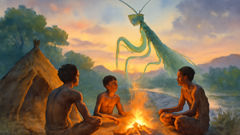
Conclusion
Cagn’s tale ends not with a single closing line but with a horizon that keeps widening. He leaves behind not a plan but a practice: observe, listen, question, and act with the care that laughter can teach but power must restrain. The world remains under his watchful, laughing gaze, forever unfinished, forever inviting. To the San and to all who come to hear him, Cagn is not merely a god of mischief but a guardian of balance—he teaches that creation is a conversation, not a conquest; that freedom is earned through temperance, and that wisdom grows from the courage to admit we do not know all the answers. The rivers carry memory to distant mouths, the mountains cradle stories, and the people carry forward the knack of turning a prank into a lesson and a joke into a bridge. In the end, Cagn’s laughter becomes a beacon: a reminder that even a small creature, a mantis with a glint in its eye, can redraw the map of the world if we choose to listen closely enough.






